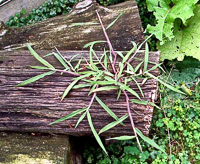 Both large
(Digitaria sanguinalis) and
smooth (Digitaria ischaemum) crabgrass
species invade home lawns. Both species are
annuals
and grow most vigorously following
germination in the late spring through mid
summer. Another common weedy grass, quackgrass (Agropyron
repens) is a perennial that lives from year
to year as the same plant.
Both large
(Digitaria sanguinalis) and
smooth (Digitaria ischaemum) crabgrass
species invade home lawns. Both species are
annuals
and grow most vigorously following
germination in the late spring through mid
summer. Another common weedy grass, quackgrass (Agropyron
repens) is a perennial that lives from year
to year as the same plant.
Since crabgrass is an annual, it germinates and
grows from seed each year. It produces
several flowering stems from a single plant and
produces many seeds from each of those stems.
The plants have no frost tolerance and are
easily killed when the first fall frost arrives.
Prior to being destroyed, they will have
produced thousands of seeds from each plant for
next year's crabgrass crop.
Control
Options: There are
three approaches to crabgrass control –
Prevention, Pre-emergence and Post-emergence.
Prevention – You will rarely find
crabgrass in a lawn that is healthy and growing
at a vigorous rate. Crabgrass invades those
small openings in a thin, unhealthy lawn.
Perhaps the single most important factor is to
mow the grass at 2.5 inches or taller. This
shades the bare soil spots and discourages
crabgrass germination. Regular fertilization
each year and irrigation during hot, dry periods
will help also. If the soil is hard and
compacted, core aeration during the spring or
fall will help the desirable grass to grow
better to the detriment of crabgrass. If you
have a lot of crabgrass this year, it is often
because your grass did not grow well the
previous year for some reason.
Pre-emergence Control: Since crabgrass is
an annual, it must germinate from seed each
spring. Chemical herbicides called
“pre-emergence” herbicides kill the new root
that comes out of the seed. The key to this
approach is timing. The crabgrass seed will not
germinate until the soil temperature is about 50
degrees F.
When the yellow flowering
forsythia bushes are
in bloom in April is a good indicator that it is
time to apply the pre-emergence product. During
a cool spring, germination may be pushed back to
May. Since the products have a short lifespan
once you apply them, it is important that they
not be applied until the soil is warm enough for
germination.
Crabgrass
preventers are excellent choices for the control
of crabgrass in the spring. Other summer annual
grassy weeds and some summer annual broadleaf
weeds may also be controlled. Be sure to follow
the label instructions for application rates.
Post-emergent Control:
The
pre-emergence herbicides will not kill plants
that were allowed to germinate and begin to
grow. So, in recent years, some herbicides have
been developed that will kill the actual
crabgrass plant while not bothering the
Kentucky bluegrass, perennial ryegrass or
fescue of your
lawn.
If you
missed the proper time for pre-emergence control
and small crabgrass plants begin to
appear in late spring or early summer, you might
want to use a post-emergent
herbicide.
Spot
treatment is best for this approach. You need to
apply the material to young plants before
they have gone to seed for it to give
effective control. If you treat later in the
season, you will still kill the current year’s
crabgrass plant but the seeds will already have
fallen to the ground and it will be back next
year. That is why the preventative and
pre-emergence approaches are by far the most
effective for homeowners.



